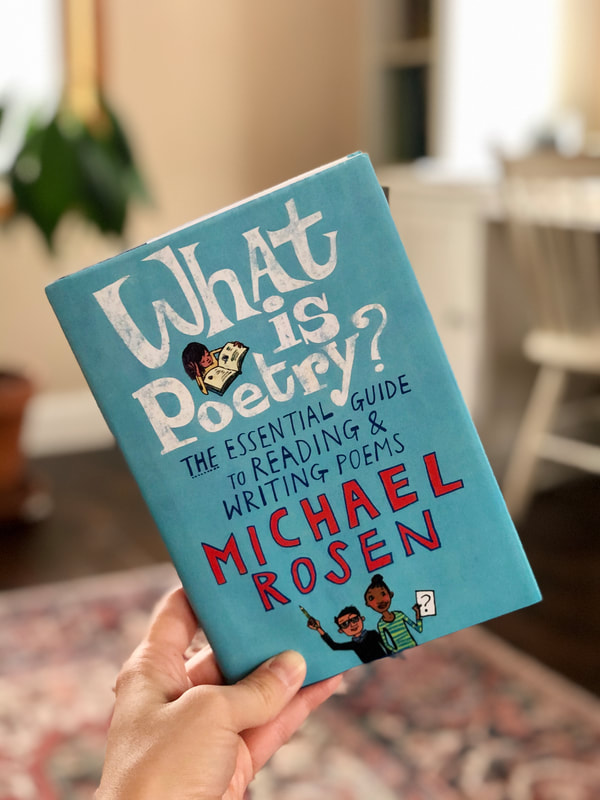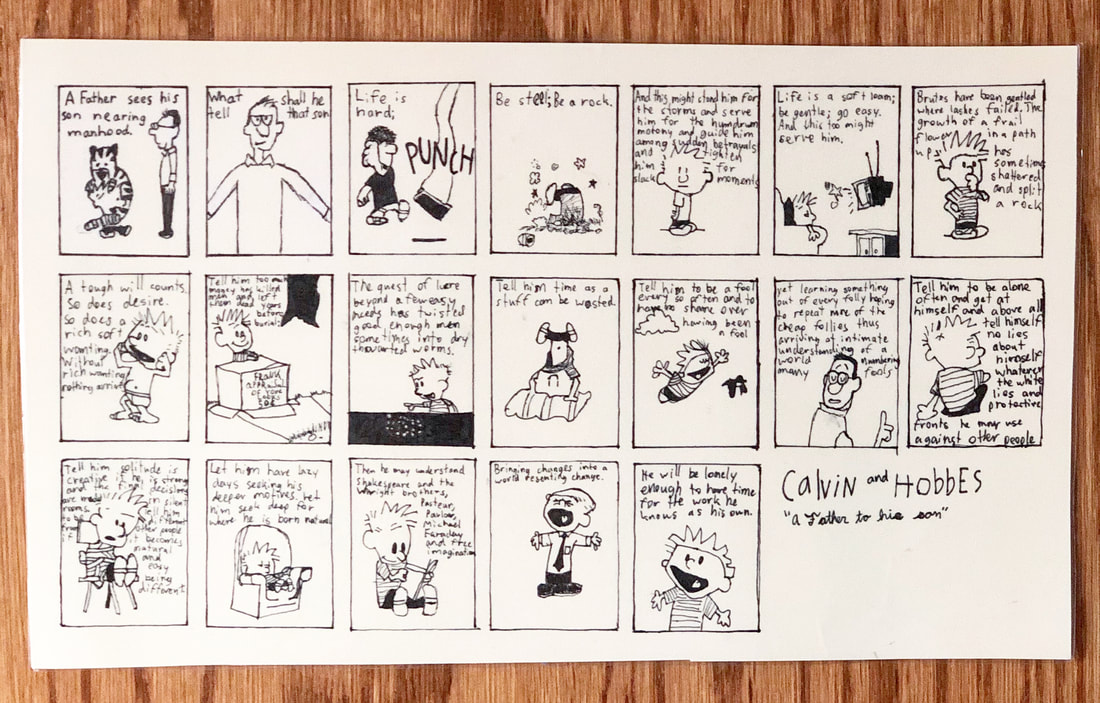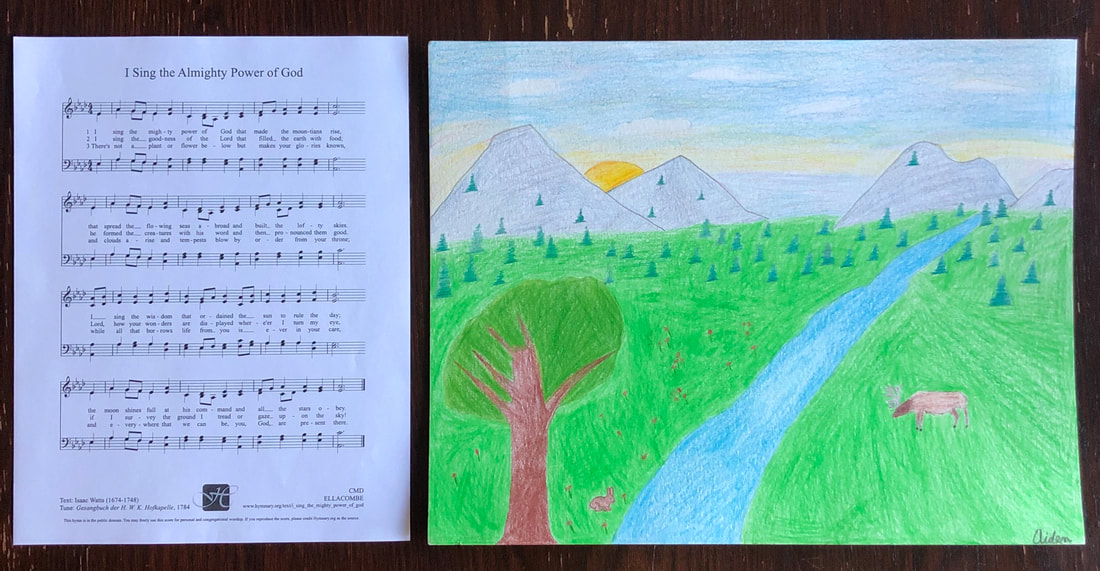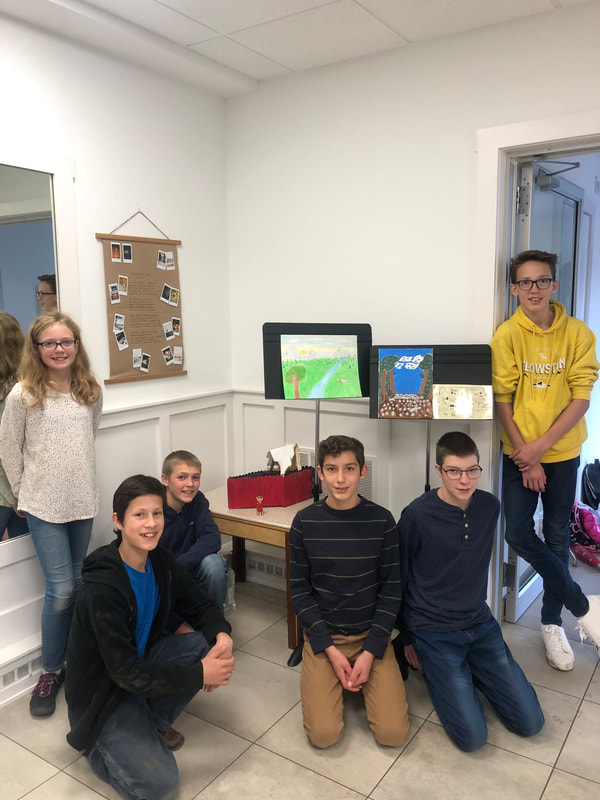This education of the feelings, moral education, is too delicate and personal a matter for a teacher to undertake trusting to his own resources. Children are not to be fed morally like young pigeons with predigested food. They must pick and eat for themselves and they do so from the conduct of others which they hear of or perceive. But they want a great quantity of the sort of food whose issue is conduct, and that is why poetry, history, romance, geography, travel, biography, science and sums must all be pressed into service. No one can tell what particular morsel a child will select for his sustenance. When I decided to teach poetry to our co-op students ages 12-15, I spent many hours researching which curriculums or books would be best to use and more importantly, would embrace the Charlotte Mason principles. The two books I landed on were What is Poetry?: The Essential Guide to Reading and Writing Poems by Michael Rosen and Grammar of Poetry by Matt Whitling from Roman Roads Press. We only used the student workbook and teacher's edition, skipping the DVDs. I felt that using these two books, in conjunction for a term, would be the best approach to teach the students to enjoy writing poetry and not become overwhelmed with all of the technicalities that can come with understanding how to write poems at this age. Each of these books had certain things I liked and disliked, but the two together, I believe, are a great complement to each other. What is Poetry? was a wonderful book in encouraging the students to write from the heart, understand different themes and messages, and explore patterns and flow of different poets. Many children start out thinking that poems must rhyme and have a certain beat, but I was pleasantly satisfied that this book opened many different doors to poetry and encouraged the students to write their own thoughts, without being confined to a set of rules. One disadvantage of this book, if using alone, is that it lacks structure, does not give students enough examples of figures of thought and tropes to practice with, leaving it to the teacher to come up with those examples. Another disadvantage I felt was that it lacked examples of well written poems. Many of the author's poems were silly, short, and twaddle-like, but of course that is my opinion and it's hard to try and not judge poetry. Being used to reading Stevenson, A. A. Milne, Kipling, Longfellow, Dickinson, Shakespeare, and even Charlotte Mason's own poetry for example, set high standards for me, and it was a bit difficult to read poems of what I felt was lesser quality.
While I do feel like there is a place for the technical things of poetry, I feel that when teaching students to write and analyze poems at this age, if they are given too rigid rules, it tends to go against Charlotte Mason's principles and leaves little room for the child to develop their own style of writing. I believe Charlotte Mason clearly emphasized over and over that when we present students with stories, poems, paintings, music, etc., we should allow them to connect with it in their individual ways instead of telling them exactly what to take away from the lesson. In addition, with written narrations, Mason was very hands off on teaching the students how they must write as we understand when we read her famous quote on lessons on composition. In fact, lessons on 'composition' should follow the model of that famous essay on "Snakes in Ireland"––"There are none." So if we understand her principles on written narrations, which poetry is a part of, we will be careful not to give students rigid rules on how to write poems, how they must rhyme, how they must include certain tropes, lines, accents, and so on. This is why I felt that taking the two books and picking and choosing what to cover and what to skip, was the best approach for teaching how to write poetry to this group of students, and staying faithful to CM's principles. And I have to humbly admit, that we had a fabulous term learning how to write poems! The students enjoyed it, wrote beautiful poems of their own, and also worked on a final project to memorize a recitation and display it in any way chosen by them. When we read through What is Poetry?, the author asked the question: What can YOU do with poetry? And thus the final project was born; I asked the students what could THEY do with their poetry recitations, and each of them came up with a creative presentation. Maybe you are looking to teach your student how to enjoy writing poetry and are wondering how exactly I combined the two books. I will say teaching each student or group of students will be different, and you might choose to do it differently, but I will share here what I chose from the 2 books and what I decided to leave out, so that Mason's principles could remain true for the children's sake. Our term was 12 weeks long and here is what our 12 weeks looked like: Week 1 What is Poetry?: read and discuss p. 1-6 Grammar of Poetry: Lesson 2 How to Read Poetry Assignment: go through poetry categories and decide which category your term recitation belongs to Week 2 What is Poetry?: read and discuss p. 7-19 Grammar of Poetry: Lesson 7 Meter (Part 1) (goes nicely with poem on p. 8-9 of What is Poetry?) + Lesson 1 Introduction and Epiphany Chart Assignment: begin to brainstorm things you could write about in your poems Week 3 What is Poetry?: read and discuss p. 20-46 (we skipped p. 28-41) Grammar of Poetry: Lesson 12 Personification (goes nicely with The Eagle poem) Assignment: write a 1 stanza poem personifying an animal Week 4 What is Poetry?: read and discuss p. 47-70 Grammar of Poetry: Lesson 9 Pun Assignment: find or write a poem with a pun ** a fun pun poem I found by Renn Nesbitt** My toes are found upon my feet My nose is on my face. You might think this would mean that each is in its perfect place. But if they were reversed, I think they'd function just as well. My nose is always running and my toes, they really smell. Week 5 What is Poetry?: review What Can Poetry Do? ~ suggest something ~play with words (puns) ~ give an impression ~ be symbolic ~ be personal ~ capture a moment ~ be ironic ~ can make new sense ~ make familiar things unfamiliar and vice versa What is YOUR recitation doing? read and discuss what can You do with a poem? p. 71-84 Grammar of Poetry: Lesson 22 Alliteration (ties in with p. 76) + Lesson 4 Rhyme (ties in with p. 80) Assignment: write a rhyming poem, 2 stanzas, including alliteration Week 6 What is Poetry?: read and discuss p. 85-95 Grammar of Poetry: Lesson 18 Hyperbole (goes along with I am Angry poem) Assignment: write a poem, 1 stanza, including hyperbole; begin to think about your term recitation and what YOU can do with your poem as discussed in p. 85-88 Week 7 What is Poetry?: read and discuss p. 115-124 (stop @ Start with a Picture) Grammar of Poetry: Lesson 5 Using a Rhyming Dictionary (this goes along with begin to write your own poetry) We used THIS rhyming dictionary Assignment: write a 2 stanza poem by either: daydreaming, pretending you are someone else, or picking a moment; begin working on recitation project Week 8 What is Poetry?: read and discuss p. 133-158 (skipped pages 148-152) Grammar of Poetry: Lesson 25 Refrain (goes along with p. 135-138) + Lesson 24 Rhetorical Question (goes along with p. 139) Assignment: write a poem using one of the 7 new ways of writing poems discussed in p. 133-158: 1. impression writing, 2. impossible writing, 3. chorus/refrain, 4. call + response, 5. Q + A, 6. word play, 7. imagism; continue working on recitation project Week 9 What is Poetry?: read and discuss p. 159-170 Grammar of Poetry: Lesson 10 Iamb (goes with p. 161, we *gently* touched on this) + Lesson 3 Simile and Lesson 6 Metaphor (goes with p. 166) Assignment: write a limerick; continue working on recitation project Week 10 What is Poetry?: read and discuss p. 171-179 Grammar of Poetry: Lesson 15 Synecdoche + Lesson 21 Onomatopoeia Assignment: write your final poem using whatever style and trope/tropes you've learned this term; continue working on recitation project Week 11: Grammar of Poetry: Lesson 27 Oxymoron + Lesson 30 Euphemism Assignment: finish final poem and recitation project Week 12: Poetry Presentation - We invited parents to listen to the students' final poems, recitations (by memory), and students shared their final project. Whew! 12 weeks flew by fast and it was an amazing term! The students learned so much about poetry, and even began using it in their written narrations in other subjects, all without being asked. It was a wonderful experience for me teaching it for the first time as well. I absolutely loved using the 2 resources combined and I truly felt that we stayed true to Charlotte Mason's principles, presenting poetry in a beautiful manner, discussing the different way of writing poetry, and allowing the students to choose how they wanted to write their own poems. Our assignments included gentle guidance, as in include alliteration or write a limerick, but the style, rhythm, topic was always left up to the students. In all we covered 17 of the 30 lesson from Grammar of Poetry. We skipped Lessons 8, 11, 13-17, 19, 20, 23, 26, 28, 29, and my reason was mainly because I did not find those lessons to be living ideas. It truly felt to me that it would take away their interest in poetry of love for it and make poetry too technical and dry. I really tried hard to keep the lessons living and create a desire in the students to experiment with writing poems. I feel that if they ever want to dig deeper into these technicalities, that we skipped, in the future, they can probably take a college level poetry classes that will discuss this at length. My goal for this class, was once again, to create a love for writing poems and to show them that they can write without being bogged down by a certain standard or strict curriculum that HAD to be done a specific way. I truly saw their desire, excitement, and eagerness to share their poems each week with the class. I hope this was helpful and will inspire you to teach your own children how to write poetry. I would really suggest waiting until they are in Form 3, grade 7+ to teach it. You might have a poet before that, and I have always encouraged poetry writing even at a young age, but I would not TEACH it until Form 3. Until then I would highly recommend making poetry a daily or at least weekly part of your school day. Pick a poet for a term or semester and read to your children their poems. Don't ask too many questions, or insist on explaining to them the meaning of the poems. Simply read and enjoy. Draw them. Act them out. Recite and memorize them. And when the children are a bit older, you can teach them how they can begin to write their own poems. Poems written by co-op students The Fellowship of the Ring by Anthony Harris Part 1 Bilbo Baggins is a Hobbit he owns a magical ring, But when the wizard Gandalf visits he does some wise thinking, It turns out that Bilbo’s ring is powerful and evil, It belongs to Sauron a great and horrid evil, Frodo Baggins is now chosen to take this magical ring, With his servant Samwise to the great elven king, Sauron sends his Nazgul riders after the Hobbit Frodo, To chase him kill him and subdue him with one great blow, Frodo must protect the ring against the agents of Sauron, One wrong step with the ring and freedom in Middle Earth is now gone, Tom Bombadil is at their side to aid them in their quest, With a song or merry tune and possibly a jest, He leads them to Bree land by way of the old Forest, And says that he must be getting back to his Goldberry dearest, The Hobbits go to the prancing pony inn were Gandalf should be waiting, Instead a mysterious ranger sits silent and steadily glaring, Should they trust this grizzled stranger or is he a spy of Sauron? Once he brings them all into his room there wondering is now done, He reveals himself as Aragorn the ranger But he is also the king of Gondor which makes all the stranger, Aragorn leads them to weathertop were they camp among the ruins, But there fire attracts the Nazgul riders who are afraid of burns, The Nazgul riders ambush them among the hills of weathertop, But Aragorn with sword and flaming torch brings them to a stop, The Fellowship of the Ring Part 2 Frodo makes it to Rivendell with Aragorn the ranger, But to the Elves and elven King he is a brave and valiant stranger, A great council is called by Elrond, During which a fellowship is formed to bring the Ring to Mount Doom and beyond, The ring bearer chosen is Frodo son of Drogo, Elrond has told him that to Mordor he must go , Samwise his faithful servant has volunteered to go, For if he had to leave his master it would bring him much sorrow, Merriadock and Peregrine are among the Fellowship chosen Frodo’s mischievous Cousins although they made noise in moria and sent the fellowship arunnin, Gandalf the grey is sent to lead them to Mordor, Although he has yet to face a great horror, Aragorn the Ranger is now a friend and not a stranger, He comes on this great quest to find the king of Gondor, Legolas the elf swears to Frodo his bow, With it he is a great shot and many orcs are laid low, Gimli the dwarf a brave and valiant warrior, Hefts up his axe and follows Aragorn to Gondor, Boromir prince of Gondor of whom his father is the steward, Joins the fellowship and with them goes westward, What happens next I must not tell Read for yourself you must do well Of the attack on the fellowship in the mines of Moria And the journey to the cracks of Doom To find out what happens next Read for yourself this first great text THE LORD OF THE RINGS BOOK 1 2020 Pandemic by Aiden Savchuk 2020 has been an interesting year, with the government telling us not to get near. "Put on your mask, It's not a hard task, Then you'll have no reason to fear." They told us to stay inside, but I would've rather died. Locked in my house, as quiet as a mouse, keeping myself preoccupied. A Boy's Prison by Kaleb Savchuk "Finishing the first term was lots of fun, From going there, we have learned a ton. I do hope though the second term will start soon, Otherwise you'll find me at the saloon," Said the boy with a somewhat genuine smile, But what had been going on in his heart all the while, "I hate school and I wanna play pool." So the more truthful poem should have been, "School is a bore, and it makes me feel like a prisoner of war, Everything is a chore and doing nothing is what I adore." Recitation projects A Father to His Son by Carl Sandburg |
| Here is a picture of the students with their final projects. Two students chose to take photographs and compile them on a poster (1 not pictured), one student did a painting, one student drew in colored pencils, one student created a Calvin and Hobbes comic strip, and one student built a model of a burning ship. |
3 Comments




